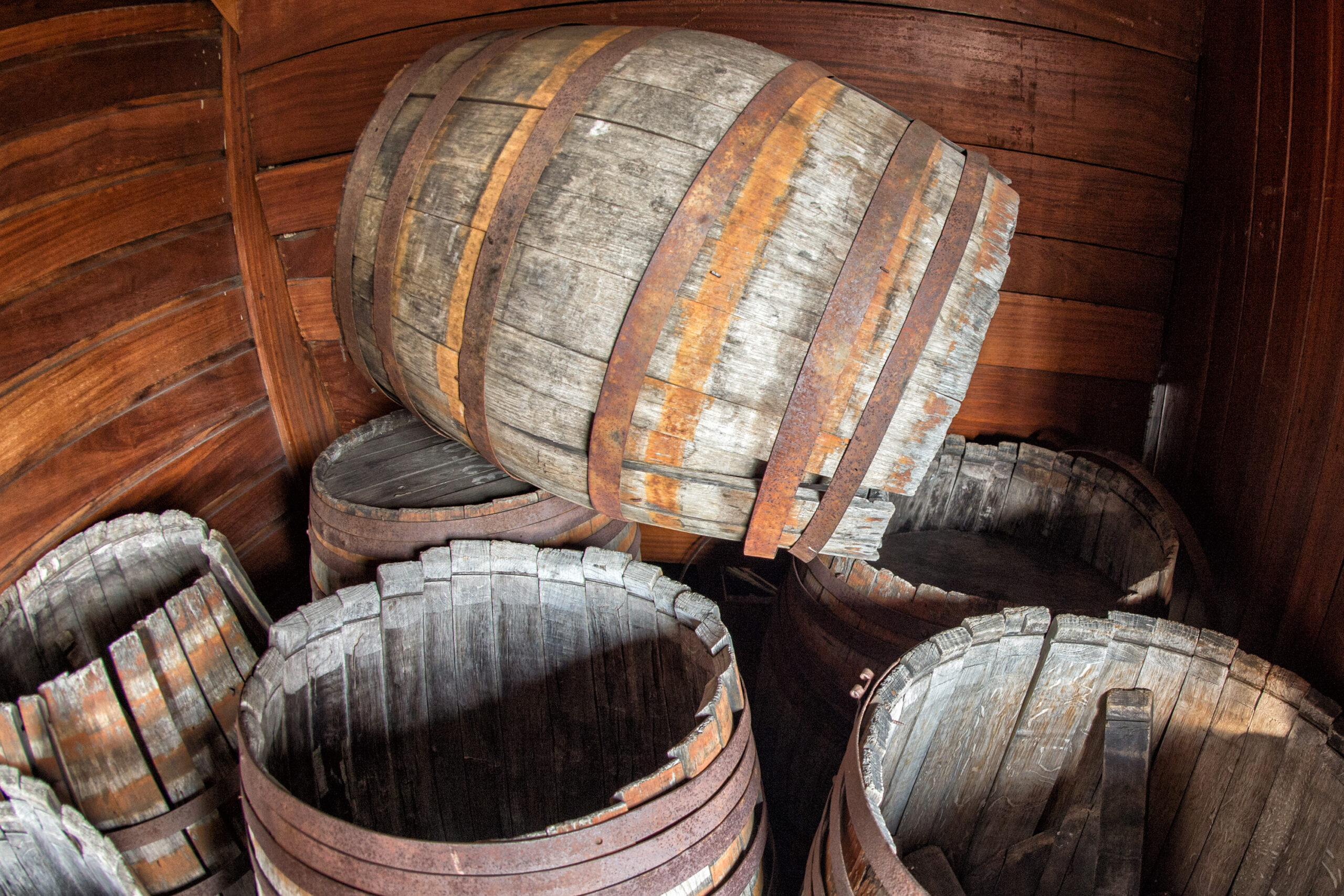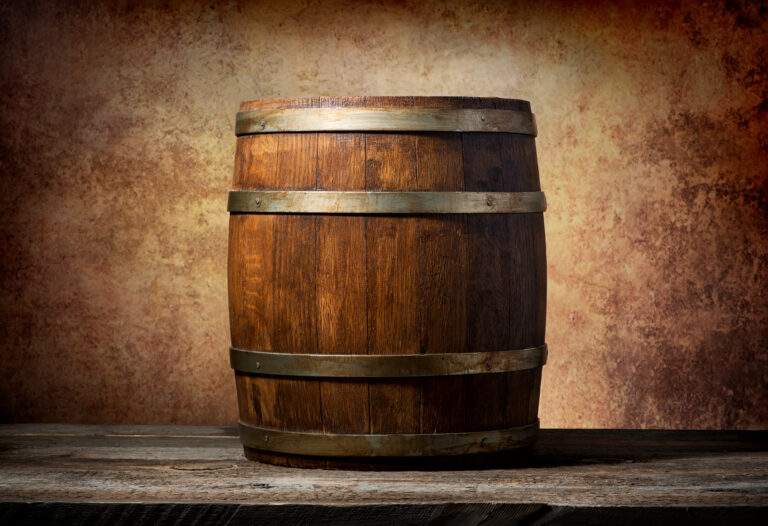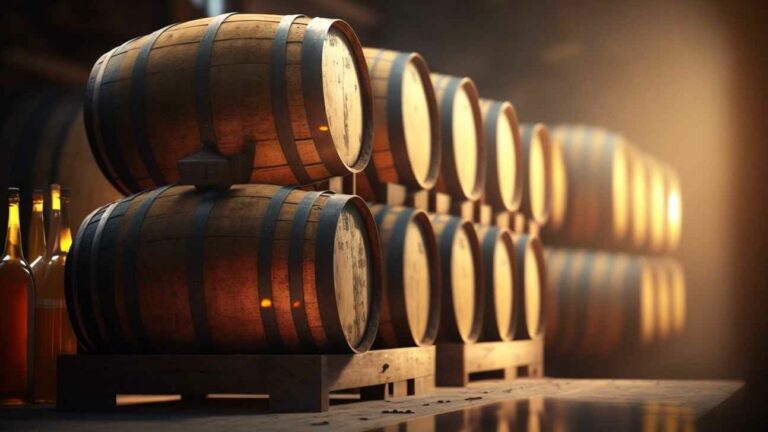Ever wondered how distilleries achieve that perfect, smoky depth in their whiskey? It’s all in the charred oak barrels! But it’s not just about filling them up and waiting. These whiskey aging barrels need some TLC to keep the flavoring and coloring spot on. Even the best oak barrels can get rust over time, especially if they’re not looked after between uses. The good news? Restoring an old barrel and tackling that rust is totally doable. All it takes is a bit of effort and the right approach.
In just a few steps, you can bring an old whiskey barrel back to life, ready to impart that signature oak and vanilla flavor into your next batch of spirits. So, grab your coarse steel wool, some distilled white vinegar, and a scrub brush. We’re about to rejuvenate this beauty and make that barrel sing again. Your whiskey will be perfectly smoky and rich in no time. Let’s get started!
Assess the Rust on Your Whiskey Barrel
First things first, let’s figure out how bad the rust damage really is. Minor surface rust is usually an easy fix, but deep, pitted rust will need a bit more muscle.
Take a good look at your barrel. Check for any cracks or holes in the wood, alongside the rust spots. Gently scrape at the rust with a wire brush or steel wool to see how deep it goes. Surface rust will flake off pretty easily, but deeper corrosion might require some serious scrubbing.
If you spot any cracks, holes, or soft spots in the wood, the rust has probably dug in deeper. In these cases, you’ll need to really clean and sand the area, then refinish the wood and seal the cracks to stop further damage to your aging barrel.
For smaller rust spots, a commercial rust remover, steel wool, and re-seasoning the barrel should do the trick. Just scrub off the rust with fine-grit sandpaper, then clean and re-season that specific area. For bigger spots, you might need to tackle the entire barrel and re-season it from scratch.
With a little dedication and the right techniques, you can make an old whiskey barrel look brand new. But remember to keep up with proper barrel maintenance to avoid future rust damage, ensuring you can enjoy your barrel for years to come!
Gather Your Rust Removal Tools and Supplies
To get that stubborn rust off your whiskey barrels, you’ll need a few key items.
First up, steel wool. Go for Grade #0000 – it’s super fine and won’t scratch your precious wood barrels. Gently scrub the rust spots to loosen the corrosion.
Next, grab some white vinegar. The acid in vinegar is fantastic for dissolving rust. Apply the vinegar with a scrub brush and let it sit until you see the rust start to bubble. Then, hit it again with the steel wool.
You’ll also want to protect yourself: gloves, eye gear, and some old clothes. Rust removal can get messy! An abrasive sponge or scrubber will be helpful too.
For really stuck-on rust, whip up a paste using baking soda and water. Apply it, let it sit, then scrub. The baking soda acts as a gentle abrasive to cut through tough rust.
With the right tools and techniques, your barrels will be rust-free and ready for whiskey storage in no time. Safety first, though – be sure to thoroughly rinse and dry the entire barrel when you’re done to avoid any skin irritation. Now, get scrubbing and bring that beautiful barrel back to life!
Lightly Sand the Rusted Areas
Gently sanding the rusted areas of your whiskey barrel is crucial for preparing the surface for a fresh coat of sealant and bringing back its original beauty.
Grab some fine-grit sandpaper, somewhere around 220 to 400 grit. Carefully sand the rust spots using small, circular motions. Be mindful not to damage the wood around the rust. As you go, wipe away any dust with a tack cloth.
For those really stubborn rust patches, you might need to start with a coarser 150 or 200 grit paper before moving to the finer stuff. Take your time and check your progress often. It’s always easier to sand a bit more than to fix an over-sanded spot!
Once you’ve tackled the visible rust, use a damp rag to wipe down the entire barrel. Let it dry completely. This will get rid of any leftover residue from sanding and let you inspect for any spots you might have missed.
With some light sanding and a new coat of sealant, your whiskey barrel will be ready to proudly display again. The fruits of your restoration efforts will be a rust-free barrel that’s truly rewarding!
Apply a Rust Remover or Vinegar Solution
To banish rust from inside your whiskey barrel, you’ll want to scrub it away and then protect the newly exposed wood. A commercial rust remover or a natural solution like vinegar will do the trick.
Apply the rust remover or vinegar solution using steel wool, scrubbing pads, or abrasive sponges. Scrub away as much of the rust as you can.
Rinse the barrel thoroughly with water to remove any lingering residue.
Once it’s clean, coat the inside of the barrel with a food-grade sealant, wax, or oil to protect the wood before aging whiskey or other spirits. Mineral or tung oil are popular, natural choices for barrel finishing.
Allow the sealant to dry as instructed. Your barrel is now ready to be filled and to continue its journey of spirit aging! With the rust removed and the wood protected, the barrel can once again subtly impart its unique flavors to the spirit.
Use Steel Wool to Scrub Off Rust Residue
After you’ve scrubbed off the loose rust and debris, you’ll probably still find some rust residue clinging to the barrel. This is where steel wool truly shines.
The finest grade, #0000, is perfect for gently scrubbing the barrel without damaging the wood. Be incredibly gentle while scrubbing to avoid scratching. Dip the steel wool in mineral or jojoba oil and scrub with light, circular motions. The oil will help loosen the remaining rust and create a protective barrier.
Rinse the barrel with water to remove any lingering debris. Keep scrubbing and rinsing until the water runs clear and most of the rust has vanished. For those stubborn rust spots, you can create a paste from lemon juice and salt or vinegar and salt. Apply the paste and let it sit before scrubbing with the steel wool. The acidity in the lemon juice or vinegar really helps to loosen the rust.
Once you’re finished, rinse and dry the barrel thoroughly. Then, apply another coat of oil or wax to protect the wood. Scrubbing with fine-grade steel wool, along with the natural acidity of lemon or vinegar, is a super effective way to restore your barrel without causing harm. With a bit of elbow grease, your barrel will be rust-free and ready for another fill of whiskey!
Rinse and Dry the Barrel Thoroughly
To truly bring back the beauty of your whiskey barrel, a thorough rinse and dry of the interior is absolutely crucial.
Once you’ve scrubbed away all the rust, flush the barrel with clean water to get rid of any remaining debris. Tip the barrel over a drain or outdoors and let the water run freely through it. Rotate and shake the barrel to ensure all surfaces are rinsed.
After rinsing, thoroughly drain any excess water from the barrel. Let it sit upside down for 10-15 minutes to allow the water to drip out. Then, stand the barrel upright and let it air dry completely, ideally for at least 2-3 days.
Leaving the barrel damp can lead to new rust forming or even mold growth. Make sure the barrel is in a spot with good airflow and away from direct heat or sunlight. The longer you can let the barrel dry, the better.
Once dry, your barrel will be ready for its next use or for display. Take a peek inside – the wood should look smooth and fresh, with no lingering rust spots. Let the aroma of the wood and the whiskey notes that have soaked into the staves over years of use delight your senses. Your barrel has been restored and is ready for its next chapter, whether that’s aging more spirits or serving as a charming decorative item in your home.
Apply a Rust-Inhibiting Sealant
Now that you’ve banished the rust from your whiskey barrels, it’s super important to apply a sealant to help prevent future rust. There are several products specifically designed for this purpose.
Look for a sealant that’s labeled as “rust-preventing” or “rust-inhibiting.” Two excellent natural options are linseed oil or beeswax. These natural sealants penetrate the wood to protect against moisture while still allowing the barrel to breathe. Apply 2-3 coats, letting each one dry in between. For areas that had stubborn rust, a commercial sealant with tung oil or acrylic might be needed.
- Linseed oil: Made from flax seeds, linseed oil dries to a hard, water-resistant finish. Just wipe it on with a cloth and buff off any excess after about 30 minutes. Reapply every 6-12 months.
- Beeswax: This creates a protective barrier by filling in the pores of the wood. Gently warm it up and rub it into the wood with a soft cloth. Reapply as needed when the wood starts to look dry.
- Tung oil or acrylic sealant: For heavy-duty protection, apply 2 coats of a product containing tung oil (derived from the tung tree nut) or acrylic, waiting 24 hours between coats. Reapply annually or as directed.
Sealing and protecting your barrels will help ensure their longevity and keep your whiskey tasting its absolute best. As the old saying goes, an ounce of prevention is worth a pound of cure! Stay on top of rust prevention, and your barrels will provide years of service. Keeping them in a sheltered area away from harsh weather is also a smart move.
With the right care and maintenance, your whiskey barrels can become a cherished part of your distilling process and history. Keep them rust-free, and they’ll keep your whiskey flavorful for generations to come!
Consider Refinishing for Added Protection
Once your whiskey barrel is completely clean and free of any leftover residue, it’s a great idea to think about refinishing the wood for even more protection. Refinishing the barrel will not only help prevent future rust but also keep your barrel looking its best for years to come.
You’ve got a few options for refinishing:
- Apply a clear sealant or lacquer. This will protect the wood while letting its natural beauty shine through. Just wipe on 2-3 coats, making sure each coat dries completely before applying the next.
- Stain the barrel a darker shade. A darker stain, like walnut or ebony, will really enhance the wood grain and can hide any minor imperfections that might remain. Apply 2 coats of stain, waiting 4-6 hours between coats.
- Paint the barrel. For a more rustic vibe, consider painting the barrel in a complementary shade like burnt umber, forest green, or navy blue. Apply a primer first, then 2 coats of paint, waiting 24 hours between coats.
- Distress the barrel for a rustic patina. After staining or painting, use steel wool, sandpaper, or a wire brush to strategically scratch and nick the surface, revealing the wood underneath. Wipe away any loose debris and then apply a sealant to lock in that perfectly distressed finish.
Refinishing your whiskey barrel will restore its inherent beauty and ensure it lasts for many more years of enjoyment. With proper care and maintenance, a refinished barrel can become a stunning decorative piece that truly stands the test of time.
Maintain Your Barrel to Prevent Future Rust – FAQs on Removing Rust From Whiskey Barrels
To keep your whiskey barrel looking its absolute best, you’ll want to maintain it properly and stop rust from making a comeback.
Once you’ve removed existing rust from your barrel, apply a coat of food-grade mineral or tung oil. These oils protect and seal the wood while still letting it breathe. Reapply every 6-12 months, or if water stops beading on the surface.
When storing your barrel, keep it in a stable environment with moderate temperature and humidity. Extreme heat or moisture can accelerate oxidation and rusting.
Routinely check your barrel for any fresh signs of rust or damage. Catching issues early makes them much easier to fix. If small rust spots do pop up, scrub them off as soon as possible with fine-grit sandpaper or steel wool and re-oil the area.
Avoid stacking heavy objects on top of your barrel that could dent or scratch its surface. When moving it, pad the rim and bottom of the barrel to prevent scuffing.
With proper care and maintenance, a whiskey barrel can give you many years of rust-free service and enjoyment. Keeping its surface oiled and protected, storing it in a suitable environment, and inspecting it regularly are the secrets to preserving your barrel’s beauty and longevity.
Final Thoughts
So there you have it – some straightforward ways to bring those old whiskey barrels back to their former glory. With a bit of elbow grease and the right tools, you’ll have them looking shipshape in no time. Once the rust is gone, you’ll be well on your way to either aging more whiskey or using the barrels as unique decor. Either way, restoring barrels is a fun project that lets you connect with a piece of history. Don’t let rusty hardware deter you – with these methods, you’ve totally got this! Bringing new life to old barrels is incredibly rewarding work, and you’ll definitely be raising a glass to your success in the end. Cheers to reviving a piece of the past and to your newfound skills as a barrel restorer!
Ready to get started on your own barrel restoration project?







